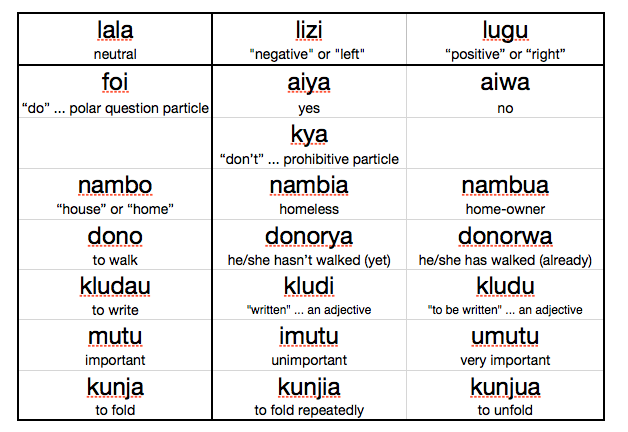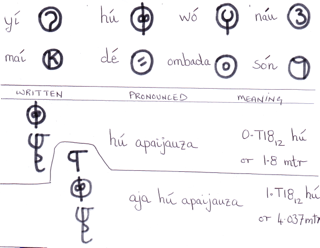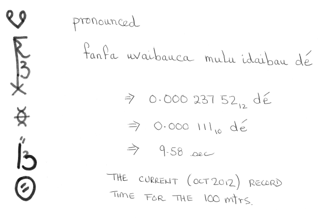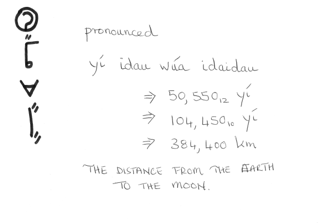Béu : Chapter 9
..... Word building
Many béu words can be analysed as being constructed from more basic elements.
We have given the structure of the béu noun phrase already (see ??). If a phrase consisting of the head plus a genitive or the head plus an adjective occur together many times and/or their meaning starts to take on nuances which are more than the sum of the two constituant elements then the two words coalesce . When 2 words coalesce ;-
1) The genitive suffix n is dropped
2) The first syllable of the first word is dropped.
3) The remainder of the first word is affixed to the second word.
Here are some examples ;-
| gxx = | to raise .............................. | gonai = | a machine | gonai gxx = | "a machine of levitation" | => | gxxnai = | a lift or an elevator |
| glxx = | to rise | tagu = | a tool | tagu glxx = | "a rising tool" | => | glxxgu = | a ladder |
| nandau = | a word | toili = | a book | toili nandau = | "a book of words" | => | nandauli = | a dictionary |
| limba = | a tongue or language | myega = | a body of knowledge, | myega limba = | "the study of language" | => | limbaga = | linguistics |
| a subject |
Word or -DAU
A word = nandau
| jaudu = | movement ............... | nandau = | a word .................... | nandau jaudu = | "a word of movement" | => | jaududau = | a verb |
| fanyo = | an object, a thing(physical) | nandau = | a word | nandau fanyo = | "a word of an object" | => | fanyodau = | a noun |
| sài = | a colour | nandau = | a word | nandau sài = | "a word of colour" | => | saidau = | an adjective |
Actually jaududau has been shortened further and is jaudau
Also fanyodau has been shortened further and is fandau
jaudauza = a predicate (verb phrase)
fandauza = a noun phrase
jaudaunyo = a noun phrase OR a noun
fandaunyo = a verb phrase OR a simple verb
sky.sound = a vowel sky.sound.za = a diphthong or a triphthong sky.sound. nyo = a vowel OR a diphthong/triphthong
earth.sound = a consonant earth.sound.za = a consonant cluster earth.sound.nyo = a consonant OR a consonant cluster
Person or -BU
A person = glabu
| ww = | a country ............................................ | glabu = | a person .................... | glabu ww = | "a person of country" | => | wwbu = | a compatriot |
| xx = | to compete, to struggle | glabu = | a person | glabu xx = | "a person of competition" | => | xxbu = | a capitalist |
| yy = | to share | glabu = | a person | glabu yy = | "a person of sharing" | => | yybu = | a socialist |
| zz = | the same ?? | glabu = | a person | glabu zz = | "a person of the same" | => | zzbu = | a communist |
Complex -ZA
A complex = kaza
Fellow or -PEU
ampeu = a fellow, a peer, someone of the same social status as you
| vv = | a womb | ampeu = | a fellow, a mate .......... | ampeu vv = | "a fellow of womb" | => | vvpeu = | a womb-mate, a twin |
| ww = | a class | ampeu = | a fellow | ampeu ww = | "a person of class" | => | wwpeu = | a classmate |
| xx = | year | ampeu = | a fellow, a mate | ampeu xx = | "a year fellow" | => | xxpeu = | somebody born in the same year as you |
| yy = | a name | ampeu = | a fellow, a mate | ampeu yy = | "a fellow of name" | => | yypeu = | a namesake, somebody with the same name as you |
| zz = | aim, objective, a purpose, a cause | ampeu = | a fellow, a mate | ampeu zz = | "a person of the same objective" | => | zzpeu = | a comrade |
Subject or -GA
A field of study = myega
Book or -LI
A book = toili
Tool or -GU
A tool = tagu
Machine or -NO
Belief/theory or -GAI
Wagon or -WEU
A vehicle = wèu
Building or -DO
bundo = building
Side or -ʔA
ʔà = side
aibaʔa = a triangle
ugaʔa = a square
idaʔa = a pentagon
elaʔa = a hexagon
ò atas nambo = he/she is above the house ... however if "house" is understood, and mention of it is dropped, we must add ka to atas ... for example ...
ò atasʔa = he/she is above
dauniʔa = underneath
liʒiʔa = on the left hand side
luguʔa = on the right hand side
noldo, suldo, westa, istu niaka, muaka faceside backside etc. etc.
Area/Station or -ʔAU
daʔau = area, face
ugaʔau = a tetrahedron
elaʔau = a cube
ezaʔau = an octahedron
ajauʔau = a dodecahedron
ajauzaʔau = an icosahedron
kas = rule, power daʔau kas => kasʔau = the townhall
Volume/Room or -ʔAI
daʔai = volume, room
moʃiʔai = water room = bathrooom
= bedroom
= cookroom
= livingroom
= store room
You can name the regular shapes in 4 dimensions.
idaʔai = a 5-cell
ezaʔai = an 8-cell
ajaugaʔai = a 16-cell
uvauʔai = a 24-cell
apauʔai = 120-cell
agaivauʔai = 600-cell
A place/station or -HEU
A place = hèu
A rule/power or -KAS
londoŋkas = the UK
pariskas = france
A place/shop or -HA
A place = há
Yes it means about the same as bwò.
Professional or -TAI
a professional (a person who's job requires book-learning) = notai
A container or -COI
A container = mencoi
Tradesman or -DA
The suffix -da indicates a person who has learnt skills through instruction and practice, practice, practice.
hand = anda
metalworker = damaida
Shop or -FU
shop/stall = kanfu
Shopkeeper or -FAU
A Seller/Shopkeeper/Merchant= kanfau
Stuff or -YO
powder = ponyo
Language or -BA
A tongue, a language = limba
Metal or -MAI
metal = damai
copper = ʔolimai
bronze = pwemai
iron/steel = gumai
tin = fujemai
lead = wobumai
aluminium = yekimai
zinc <= needle ??
gold <= sun ??
silver <= moon ??
Water or -ZE
water = moze
moze amazon = water of Apple => Apple Juice = amaze
ʔolaze = orange juice
hawan = bee
hawanze = honey
Air/gas or -ME
Air/gas = came ... jamu = wind
hydrogen = mozeme
helium = ombame
Group or -BO
mebo = group
Member or -KE
noke = member
Disease or ʔI
lisʔi = disease
Fish or -SAI
a fish = fizai
Note ... fish in general are fiʒi
cuttlefish = byozai
Trees or -PAI
a tree = ʔupai
Note ... a forest is ʔupo
Apple tree = amapai
Mango tree = byopai
Fruit/nuts or -ZO
Apple = amazo
Mango = byozo
We do not want a "unit", "boat".
⁕⁕nandauli is a good example of béu word building. toili = book, nandau = word, toili nandaun = book of words. However if two words such as these geudidau means extended word. It is also a good example of an extended word, in itself.
geuda is a verb meanbéuing to extend in one direction (usually not up). geudo is an noun meaning an extension or appendix. geudi is an adjective meaning extended.
nandau geudi = extended word ... now when a noun and a following adjective occur together a lot (and maybe take on a meaning slightly different) the concept they represent is normally upgraded to a word, by deleting all but the last CV (consonant vowel) in the first word, and sticking this CV on to the end of the second word.
Hence we get geudidau. In theory there is no limit to the combinations that can occur. However in practice (outside of technical language) there are slightly under a hundred different CV's, and the number of elements that every CV can combine with, varies from 3 or 4 up to about 40.
In English we have a number of common endings, such as "-ism", "-ology", "ist", etc. etc. In béu the end-stuck CV's can be thought of as equivalent to these English endings : the main difference is that this word building process is much more prevalent in béu.
The CV -dau (from nandau) is found in combination with a number of other elements. For example ;-
Note that in the last example, the meaning of the extended word has shifted a bit with respect to the meaning of the original words.
It is possible to extend further an extended word. For example ;-
kaza is an adjective meaning compicated and also is a noun meaning "a complicated thing" or "a complex".
kaza cwipadaun = a complex of a noun => cwipadauza = a noun phrase
..... More word building
Nominalizer to make uncountable intangible nouns -GAN
..
| béu | beugan | ||
| hái | high, tall | haigan | the first dimension or an objects position in the first dimension |
| joga | broad | jogan | the second dimension or an objects position in the first dimension |
| guboi | deep | gugan | the third dimension or an objects position in the first dimension |
..
Nominalizer to make uncountable intangible nouns -VAN
Adjectivalizer to make adjectives with the meaning "attracted to" -WAN
..
wan is affixed to a few nouns and a few adjectives. Its has the sense of "liking", "tending towards", "accustomed to" or "addicted to".
| ái | white | aiwan | faded |
| lozo | grey | lozwan | grizzled |
| pà | I | pawan | selfish |
| mama | mother | mamwan | motherbound |
| nambo | house | nambwan | domesticated |
| toili | book | toilwan | bookish |
| alka | alcohol | alkwan | (an) alcoholic |
| alha | flower | hawan | a bee |
As you can see, the derived word can have some erosion.
..
Adjectivalizer to make adjectives with the meaning "repelled by" -DUS
..
dus is affixed to a few nouns and a few adjectives. Its has the sense of "disliking", "scared of", "avoiding" or "hating".
| ʔazwo | milk | ʔazwodus | lactose intolerant | ||||
| glabu | person | glabudus | timid, shy (of an animal) | ||||
| moze | water | mozdusʔi | rabies | ||||
| --- | an electron | ---wan | positively charged | ---dus | negatively charged | wandus | charge (electrical) |
| omba | sun | ombadus | nocturnal | ||||
| nambo | house | nambodus | wild (as in wild animal) |
..
Depository for béu linguistic terms
LINGUISTIC JARGON ... In the Western linguistic tradition, these markers are said to represent "person" and "number". Person is either first, second or third person (i.e. I, you, he or she). In the béu linguistic tradition they are called cenʔo-markers. (cenʔo = musterlist, people that you know, acquaintances, protagonist, list of characters in a play)
These markers represent the subject (the person that is performing the action). Whenever possible the pronoun that represents the subject is dropped, it is not needed because we have that information inside the verb with the cenʔo-markers.
Now these markers represent what are called tense/aspect markers in the Western linguistic tradition. In the béu linguistic tradition, they are called gwomai or "modifications". (gwoma = to alter, to modify, to adjust, to change one attribute of something).
4) and finally one of the 4 teŋko-markers shown below is added.
teŋkai is a verb, meaning "to prove" or "to testify" or "to give evidence" or "to demonstrate" ... teŋko is a noun derived from the above, and means "proof" or "evidence".
By the way, the béu terms for the five aspects represented by these 5 rows are ... baga, dewe, liʒi, pomo and fene ... i.e. in the tense/aspect table.
doikoryi => He/she had not walked ... doikorya => He/she hasn't walked yet ... doikoryu => He/she will not have walked Quite often this tense is followed by the word ki.e. This emphasises the "present time" meaning (This probably would not be necessary if the -w- tense had not included the "at least once" meaning). ???
Limitations of my tense/aspect system ...
Note .... Even with 16 tense/aspect markers, not every situation can be exactly expressed.
For example suppose two old friends from secondary school meet up again. One is a lot more muscular than before. He could explain his new muscles by saying "I have been working out" (using the progressive plus the perfect aspects). The "have" is appropriate because we are focusing on "state" rather than "action". The "am working out" is appropriate because it takes many instances of "working out" (or working out over some period of time) to build up muscles. béu has no tense/aspect marker so appropriate.
Every language has a limited range of ways to give nuances to an action, and language "A" might have to resort to a phrase to get a subtle idea across while language "B" has an obligatory little affix on the verb to economically express the exact same idea. You could swamp a language with affixes to exactly meet every little nuance you can think of.
By the way, for the above example, in béu, the muscular schoolmate would use the r form of the verb plus the béu equivalent of "now" ki, to explain his present condition ... good enough.
AND I EXPLAIN WHAT THE PERFECT IS ...
While the perfect tense, logically this doesn't have that much difference from the past tense it is emphasising a state rather than an action. It represents the state at the time of speaking as the outcome of past events. We have this tense/aspect in English and it is realized as "have xxxxen". For example if you wanted to talk to John and you went to his office, his secretary might say "he has gone to lunch" (as opposed to "he went for lunch"), which emphasises the absence of John. And think about the difference in meaning between "she has fallen in love" and "she fell in love" ... the first one means "she is in love" while the second one just talks about some of her history.
MORE ABOUT THE "ALREADY" & THE "NOT YET" TENSE
I read the book on geometry .... this doesn't specify whether you read it all or whether you read just a bit of it. .... (the past tense)
So ... I have read the book on geometry ... is more specific ... I have read it all the way thro'. .... (the perfect)
And by default, the perfect implies current relevance, it describes what kind of person I am NOW .... a person with some knowledge of geometry.
Now in the example above the "time window" is not important (assuming you don't forget things easily). If you read the book five years ago or last week ... you are still a person with some knowledge of geometry.
I will talk about "wide time" and "narrow time". "narrow time" comprises only the recent past but "wide time" comprises the recent past plus time periods further back.
But take this example .... a man saying to his daughter ... "Have you cooked chilli con carne" (OK ... assume the man is speaking a language with no definite article. In English "Have you cooked the chilli con carne" is "narrow time", "have you cooked chilli con carne" is "wide time".
Does he mean ... "have you finished tonights meal" or is he saying "do you possess the ability to cook chilli con carne" .... "narrow time" versus "wide time"
To make himself explicit he will perhaps add "already" to help specify "narrow time". Or he may add "ever" or "before" to help specify "wide time".
IS THIS ONE OF THE REASONS THAT SOME LANGUAGES HAVE 4 PAST TENSES ... TO GIVE THIS "narrow time", "wide time" distinction ???
So people find it necessary to define the 2 situations (one regular one a once-off) in a different way tense-wise.
YīnYáng
liʒi and lugu can be considered the béu equivalents of Yin and Yang.
According to the Taoist tradition ...
Yin is characterized as slow, soft, yielding, diffuse, cold, wet, and passive; and is associated with water, earth, the moon, femininity and nighttime.
Yang, by contrast, is fast, hard, solid, focused, hot, dry, and aggressive; and is associated with fire, sky, the sun, masculinity and daytime.
Unfortunately the béu tradition is not so delightfully colourful. It is more workaday.
It is basically the association in morphology of the sound i to the negative, and of u to the positive.
Also there is a weaker association of i to the left and the past, and of u to the right and to the future.
wa or -ua or to a lesser extent u- are associated with positiveness.
Also ya or -ia or to a lesser extent i- are associated with negativity.
kludi and kludu might be expected to be swopped over ...
-i is suffixed to indicate an action already done on an object and hence there IS NOT any action pending. ( IS NOT = negative )
-u is suffixed to indicate an action IS pending. ( IS = positive )
Also i is associated with past time and u is associated with future time (refer to the tense/aspect markers).
In the béu mathematical tradition the primary axis is always horizontal. The origin is called the lalapoint.
Negativity is to the left of this point and positiveness to the right. ( OK not so much difference from the way we do things in the West )
In calculus there is a strong preference to vary other dimensions with respect to time.
Units
We have alread discussed numbers quite extensively.
Now it is time to discuss béu units (jada).
The unit of distance is the cwài (3.68 km) ... this is actually the radius of the earth divided by 100012.... cwì = "distance"
The unit of height is the hú (2.13 m) ... this is actually the yí divided by 100012.
The unit of weight is the wó (5.6 kg) ... this is actually (the weight of water in a cube with every side one hú long) divided by 100012.
The unit of area is the náu (7,839 m2) ... this is actually (the area of a square with every side one hú long) multiplied by by 100012.
The unit of temperature is the mái (87 degrees Kelvin). This makes the temperature of the human body equal to 3 1/2 units.
Also 3.0 mái is -12 degrees celsius and 4.0 mái is 75 degrees celsius. As the temperature of the air is nearly always between these two limits, when people discuss the weather, they normally drop the "3".
The unit of time is the dé (24 hours).
The unit of angle is the ombada (360 degrees).
The unit of speed is the són (0.15333 km/hour)
The above units are not normally written out in full. But they have special symbols as given below.
Now we must lay down how the unit word interacts with the number and with the 7 number "placeholders". This must be defined for both speech and notation.
Well first of, if the number is such that it is next to omba (the decimal point), then omba is replaced with the units being used (in both recitation and in notation). For example hú is the unit used to measure height (it equals 2.237 mtr). My height (1.8 mtrs) would be pronounced hú apaijauza. A height of 4.037 mtrs would be pronounced as aja hú apaijauza. (see the chart above to see how this would be written down).
Now if the number doesn't occur next to omba but on one side of a placeholder, then the unit is placed on the opposite side from the placeholder.
If the number occurs on both sides of a placeholder, then the unit is place at the very front.
Notice that in the notation the numbers must be contiguous with the placeholders. If there is a gap, then the sign for "h" must be inserted into the gap. Exactly as we insert zero's. But one different between our system and the béu system, is, in our system, zero's must be inserted to make the number contiguous with the decimal point (assuming we are using non-scientific notation), in the béu system "h"'s must be inserted to make the number contiguous with any placeholders that are used.
The béu system may at first appear more complicated then the systems currently used. However it is all a matter of familiarity. It is just due to exposure to it for most of our lives that, for example, using hours, minutes and seconds seems so easy. With all equal amount of exposure, the béu system would be even easier.
In our SI system, magnitude words are prefixed to the unit of measurement (for example "kilo" in kilometre). béu also has magnitude words (the placeholders) but they are inserted into the number itself (the béu system is better than the SI system because you get a different magnitude word every time your dynamic range passes 1728). Notationwise, it is a bit similar to the way we use comma's to separate a long number string into groups of three digits.
This is rubbish
The plovaza (adjective phrase) is a clause that sets the scene for the main action.
1) "waiting on tables six nights a week", Kirsty had come to know all the regular customers // "their mains flowing", they ran across the field and down to the river.
2) "his leg broken", he slowly crawled up the sand dune and ...
3) "having to pack all the stereos before lunch", he did not stop for a tea-break.
In English grammar this is called a nominative absolute construction. It is a free-standing (absolute) part of a sentence that describes or modifies the main subject and verb. It is usually at the beginning or end of the sentence, although it can also appear in the middle. Its parallel is the ablative absolute in Latin, or the genitive absolute in Greek.
Index
- Introduction to Béu
- Béu : Chapter 1 : The Sounds
- Béu : Chapter 2 : The Noun
- Béu : Chapter 3 : The Verb
- Béu : Chapter 4 : Adjective
- Béu : Chapter 5 : Questions
- Béu : Chapter 6 : Derivations
- Béu : Chapter 7 : Way of Life 1
- Béu : Chapter 8 : Way of life 2
- Béu : Chapter 9 : Word Building
- Béu : Chapter 10 : Gerund Phrase
- Béu : Discarded Stuff
- A statistical explanation for the counter-factual/past-tense conflation in conditional sentences



